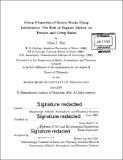Creep properties of source rocks using indentation : the role of organic matter on texture and creep rates
Author(s)
Slim, Mirna I
DownloadFull printable version (39.82Mb)
Other Contributors
Massachusetts Institute of Technology. Department of Earth, Atmospheric, and Planetary Sciences.
Advisor
Franz-Josef Ulm.
Terms of use
Metadata
Show full item recordAbstract
Gas shale formations are source rocks of variable mineralogy with oil and natural gas production potential. Due to their low permeability, these source rocks can be produced only after fracturing. Therefore, understanding and characterizing the time-dependent mechanical properties of these formations are of outmost importance. This work analyzes the role of organic matter affecting texture and driving creep behavior in source rocks. To isolate the porous organic-rich clay composites, we adopt elaborate methodology that uses the mechanical properties probed with the indentation technique, chemistry obtained from spectroscopy, and chemo-mechanical clustering analysis. We characterize the nanoscale mechanical properties and anisotropy of these composites and show that micromechanical textural modeling depicts the effects of organic maturity on texture and successfully captures and isolates those effects. Our research reveals that creep in organic-rich shale formations is logarithmic and driven by the porous kerogen phase. The organic matter plays a pivotal role as it affects energy dissipation in the composite with deformations. This conclusion is reached by inspection of (nano- and micro-) indentation creep results, analysis of secondary consolidation by adapting the relevant tools of soil mechanics to nanoindentation, and inspection of changes in packing density of the clay composites with creep deformation. Creep composite modeling reveals that the clay composites lie within two asymptotes defined by textures that relate to the connectivity of the porous kerogen phase. A comparison of creep microindentation data with triaxial creep tests validates creep indentation as a means to understand, quantify, and predict creep behavior of source rocks that extends beyond the test duration. Creep microindentation, thus, saves experimentation time and specimen volume. Empirical maturity-dependent scaling relationships between creep rates and both stiffness and hardness are obtained. These relationships are potential additions to petrophysical workflows leading to better fracture planning, which, in turn, reduces the environmental impact of fracturing jobs and production costs.
Description
Thesis: Ph. D., Massachusetts Institute of Technology, Department of Earth, Atmospheric, and Planetary Sciences, 2016. Cataloged from PDF version of thesis. Includes bibliographical references (pages 385-404).
Date issued
2016Department
Massachusetts Institute of Technology. Department of Earth, Atmospheric, and Planetary SciencesPublisher
Massachusetts Institute of Technology
Keywords
Earth, Atmospheric, and Planetary Sciences.